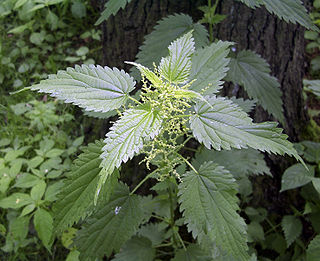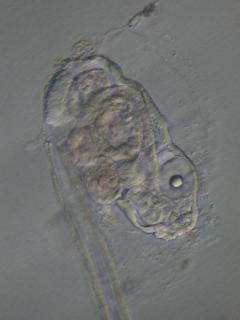
Allspice, also called pimento, Jamaica pimento, Jamaica pepper, pimenta, or myrtle pepper, is the dried unripe fruit of Pimenta dioica, a midcanopy tree native to the Greater Antilles, southern Mexico, and Central America, now cultivated in many warm parts of the world. The name "allspice" was coined as early as 1621 by the English, who thought it combined the flavour of cinnamon, nutmeg and cloves.

Bryonia is a genus of flowering plant in the gourd family. Bryony is its best-known common name. They are native to western Eurasia and adjacent regions, such as North Africa, the Canary Islands and South Asia.

Urtica dioica, often known as common nettle, stinging nettle or nettle leaf, or just a nettle or stinger, is a herbaceous perennial flowering plant in the family Urticaceae. Originally native to Europe, much of temperate Asia and western North Africa, it is now found worldwide, including New Zealand and North America. The species is divided into six subspecies, five of which have many hollow stinging hairs called trichomes on the leaves and stems, which act like hypodermic needles, injecting histamine and other chemicals that produce a stinging sensation upon contact. The plant has a long history of use as a source for traditional medicine, food, tea, and textile raw material in ancient societies.

Urtica is a genus of flowering plants in the family Urticaceae. Many species have stinging hairs and may be called nettles or stinging nettles, although the latter name applies particularly to Urtica dioica.

Antennaria is a genus of herbaceous perennial plants in the family Asteraceae, native to temperate regions of the Northern Hemisphere, with one species in temperate southern South America; the highest species diversity is in North America. Common names include catsfoot or cat's-foot, pussytoes and everlasting.

Antennaria dioica is a Eurasian and North American species of flowering plants in the Asteraceae family. It is found in cool northern and mountainous regions of Europe and northern Asia, and also in North America in Alaska only.

Silene dioica, known as red campion and red catchfly, is a herbaceous flowering plant in the family Caryophyllaceae, native throughout central, western and northern Europe, and locally in southern Europe.

Mammillaria dioica, also called the strawberry cactus, California fishhook cactus, strawberry pincusion or fishhook cactus, is a cactus species of the genus Mammillaria. Its common name in Spanish is biznaga llavina.

Urtica dioica subsp. galeopsifolia, the fen nettle or stingless nettle, is a herbaceous perennial plant found in Europe. It is considered to be either a subspecies of stinging nettle, or a species in its own right: Urtica galeopsifolia.
British NVC community OV25 is one of the open habitat communities in the British National Vegetation Classification system. It is one of four tall-herb weed communities.

Oikopleura dioica is a species of small pelagic tunicate found in the surface waters of most of the world's oceans. It is used as a model organism in research into developmental biology.
Astathini is a tribe of longhorn beetles of the Lamiinae subfamily. It was described by Thomson in 1864.
Bacchisa is a genus of longhorn beetles of the subfamily Lamiinae.
Bacchisa aulica is a species of beetle in the family Cerambycidae. It was described by Pascoe in 1867. It is known from Sulawesi.
Bacchisa papuana is a species of beetle in the family Cerambycidae. It was described by Breuning in 1956.
Bacchisa kraatzii is a species of beetle in the family Cerambycidae. It was described by Thomson in 1865. It is known from Java and the Philippines.
Bacchisa guerryi is a species of beetle in the family Cerambycidae. It was described by Pic in 1911. It is known from Laos and China. It contains the varietas Bacchisa guerryi var. apicalis.
Bacchisa coronata is a species of beetle in the family Cerambycidae. It was described by Pascoe in 1866.
Bacchisa fortunei is a species of beetle in the family Cerambycidae. It was described by Thomson in 1857. It is known from Japan.

Lonicera dioica is a vine in the honeysuckle family native to Canada and the eastern and central United States.












